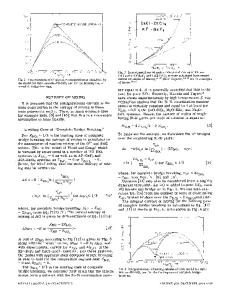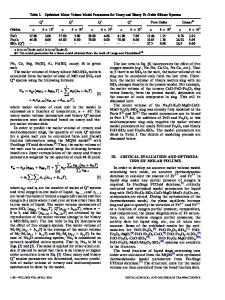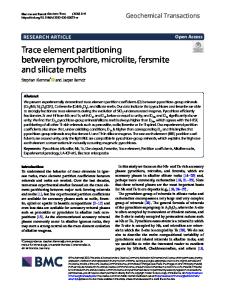A model for silicate melts
- PDF / 357,808 Bytes
- 3 Pages / 603.28 x 783.28 pts Page_size
- 79 Downloads / 367 Views
Pb as Pb304/g of ZnS
4.
O O'035 g C
._O
17 0 " l ~ g
O x W
5.
A 010g
60
6.
40
7.
C N
N
8.
20
9. 10.
0
1/2
1
11/2
2
2112
Time, hours Fig. 4 - - E f f e c t of increase in lead content as Pb304 during ammonia leaching of pure zinc sulfide. Conditions: 10 g ZnS, 3.7 M NH3, temperature 373 K, and pO2 202 kPa.
11. 12. 13. 14.
the difference between the initial lead and estimated soluble lead. By keeping the initial P b / Z n S ratio as 0.1, the amounts of insoluble lead for Pb(NO3)2, P b S O 4 , and Pb304 were 28, 25, and 24 mg per gram of ZnS. The same amount of insoluble lead (probably as PbS) explains similar extents of extraction using Pb(NO3)2, PbSO4, or Pb304. The X-ray diffraction patterns obtained for the sample prepared by the addition of Pb(NO3)2 to ammoniacal ZnS slurry were complex but showed the presence of PbS. However, the intensities of some lines did not exactly match the ones given in the A S T M I n d e x . tl61 The increase in zinc extraction with the increase in galena amount (Figure 1) is due to more lead sulfide available in the system. The extraction of zinc from zinc sulfide under ammoniacal conditions increases in the presence of PbS, PbSO4, Pb(NO3)2, and Pb304. The formation of PbS on addition of Pb(NO3)2, PbSO4, or Pb304 to ammoniacal ZnS slurry has been confirmed. The limited increase in zinc extraction in the presence of lead compounds other than PbS was found to be due to limited formation of lead sulfide. However, the mechanism for the formation of PbS in the presence of Pb(NO3)2, PbSO4, and Pb304 and the participation of PbS in enhancing the dissolution of zinc sulfide need to be further investigated.
The authors are thankful to Dr. S. Acharya for useful discussions during the preparation of this manuscript. The authors are grateful to Prof. P.K. Jena, Director, Regional Research Laboratory, Bhubaneswar, for his kind permission to publish this paper. REFERENCES l. H. Majima and E. Peters: Trans. TMS-AIME, 1966, vol. 236, pp. 1409-13. 2. S. Anand, K.S. Rat, S. Acharya, and R.P. Das: Proc. Xlth 404--VOLUME 21B, APRIL 1990
15. 16.
National Conf. for Treatment of Minerals and Hydrometallurgy, Natal, Brazil, 1985, vol. 2, pp. 234-45. M.C. Kuhn and N. Arbiter: l l t h lnt. Mineral Processing Congress, Cagiliari, Sardinia, Italy, 1975, paper no. 30. P.R. Jochens, M.J.S. Lombard, and De W. Breed: Report No. 1769, National Institute of Metallurgy, Johannesburg, South Africa, 1976, p. 20. K.S. Rat, S. Anand, K. Srinivas Rat, S.C. Das, T. Subbalah, and R.P. Das: Trans. Indian Inst. Met., 1984, vol. 37, pp. 49-53. R.P. Das, S. Anand, and K.S. Rat: Trans. Indian Inst. Met., 1984, vol. 37 (1), pp. 54-58. D.J.K. Evans, S. Romanchuk, and V.N. Mackiw: Can. Min. MetaU. Bull., 1964, vol. 628, pp. 857-66. M.K. Ghosh, S. Anand, and R.P. Das: Hydrometall., 1989, vol. 21, pp. 207-21. I.M. Nelen and S.I. Sobol: Sbornik Tru. Gos. Nauch. Issl. Inst. Tsv. Metals, 1959, vol. 15, pp. 447-75; Chem. Abs., 1960, vol. 54, p. 20731b. I.M. Nelen and S.I. Sobol: Sbornik Tru. Gos. Nauch. Issl. In
Data Loading...











